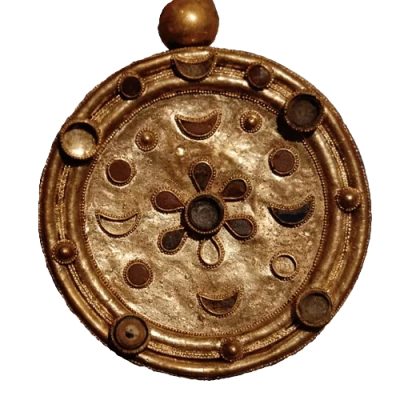Necklace with medallion, gold, carnelian, rock-crystal and semi precious stones, Byblos, 3200 – 2000 BCE. Diameter 5.8 cm
“The medallion belongs to a group of gold ornaments known from Iran, Iraq, Syria, Lebanon and Cyprus, which are decorated in different techniques. The design may be applied box settings for inlay with added granulation, as in no. 85, or it may be embossed or worked repoussé, so that the punched dots serve as imitation of the globules. The nearest parallel to our jewel is a pendant from Tepe Giyan near Nihavend (Iran) published by Herzfeld, and dated by him c. 2200 B.C. It is published again with more ornate examples found near Hillah-Babylon in a closed jar, attributed to the First Dynasty of Isin, hence to the end of the third and early second millennia. All these have gold beads attached at the top of the disk, so that it can be worn as a pendant, whereas the Montet medallion has enly a simple loop placed at the back where it cannot be seen.”




- Relations between Byblos, Egypt and Mesopotamia at the end of the third millenium B.C. A Study of a Montet Jar. [article]
O. Tufnell, W. A. Ward. Syria. Archéologie, Art et histoire Année 1966 43-3-4 pp. 165-241 https://www.persee.fr/doc/syria_0039-7946_1966_num_43_3_5872 - Granulation and Glass: Chronological and Stylistic Investigations at Selected Sites, ca. 2500-1400 B. C. E.;
Christine Lilyquist https://www.jstor.org/stable/1357319
Gonur Depe – gold “medallions”. Margiana (Bactria), 18th-15th C BCE [d/b]
An intact cist from an intact burial #560″Three gold (two identical designs and one different)…
Brooch, Roman period, Maikop [d/b]
Photo ©Carole Raddato Brooch from Maikop [Republic of Adygea, Black Sea region]Gold, garnet, carnelian, glass….
Medallion from Syria? Facebook -> Red List -> Auction
Image: Example of a Red List artifact from Syria being trafficked on Facebook in ATHAR…
Medallion, Roman Imperial, RGM Köln [d/b]
Gold medallion / pendant with a black-green glass “stone”.Diameter of the gold plate: 4.3 cm….
Silver bust of Dionysus, Taxila, 1st C BCE – 2nd C CE [d/b]
Photo source https://stories.durham.ac.uk/Marshall100/ Silver medallion found at Sirkap, Taxila by John Marshall. Repoussé bust of…
Brooch with Goddess Fortuna, Crimea [d/b]
Photo ©Scythian Naples Museum https://neapolis-scythian.com/enФибула брошь с изображением богини Фортуна, некрополь Каратау, II – III…
Gold medallion with “Virgin Mary”, Byzantine [?] [auction]
“An exceptional Early Byzantine gold pendant in the shape of a medallion, featuring the draped…
Gold medallion with a female bust, Byzantine [?] [auction]
“Byzantine Gold Medallion with the Bust of an Empress and GarnetsCulture: ByzantinePeriod: 7th-8th century A.D.Material:…
Gold brooch, Roman, 2nd-3rd century [auction] [d/b]
© TimeLine Auctions Limited Roman gold oval plate fibula, with a central inlay of sardonyx…
Prowincjonalno-Rzymskie brosze
Broszka okrągła z małymi, półokrągłymi wypustkami na krawędziKurhan nr 1/1980, grupa Lebedevka II, Kazachstan, II-III…
Brooch with pendants, 2nd-4th century Croatia [d/b]
Photo ©Sisak City Museumhttps://muzej-sisak.hr Tea Tomaš Barišić, Nakit iz zbirki Gradskog muzeja Sisakhttps://www.academia.edu Gold and…
Georgia, medallion, 3rd-4th century [d/b]
Photo after Helen Giunashvili Photo after Nino Kalandadze Samtavro’s tomb, Kvakuti M94 1938.Intaglio garnet (pyrope),…























